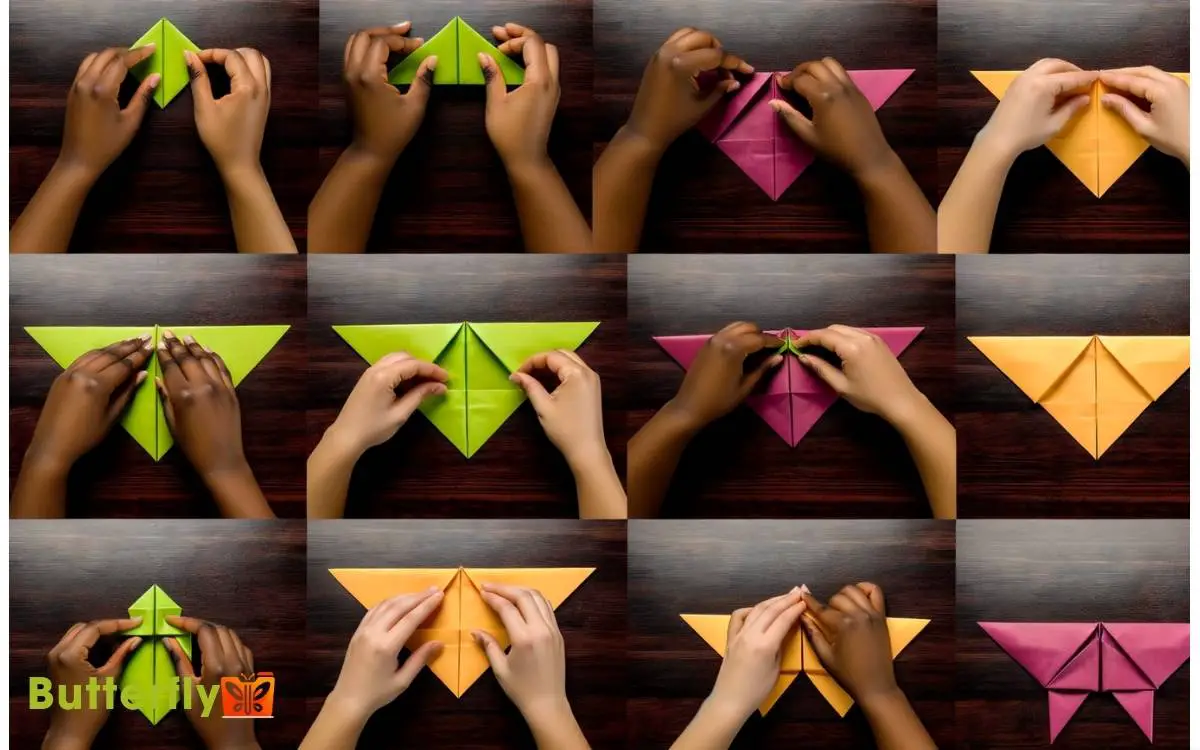How To Make A Flying Paper Butterfly? Step-by-Step Tutorial!
To make a flying paper butterfly, gather sharp scissors, a ruler, pencil, sturdy rubber band, and paper clips.
Choose paper with a weight of 70-100 GSM. Draw a butterfly outline on cardstock, fold for symmetry, and add patterns.
Cut out the shape carefully, refining curves and verifying symmetry. Decorate with vibrant colors, metallic tones, and glitter.
Form a gentle curve on the central crease, fold the lower wings upward, and attach a small elastic band centrally for balance.
Test in an open space, adjusting the wing and band as needed to perfect the flight. Discover more to master this whimsical creation!

Key Takeaways
Gather Your Materials
To start your flying paper butterfly project, you’ll need to gather a few essential materials.
- First, grab a pair of sharp scissors for precise cuts.
- You’ll also need a ruler to measure out exact dimensions, ensuring symmetry in your butterfly’s wings.
- A pencil will help you sketch your design accurately.
- Don’t forget a sturdy rubber band, as it provides the elastic energy necessary for flight.
- Additionally, find some paper clips; these will serve as the mechanical parts that hold your butterfly together.
- Finally, clear tape is essential for securing all components seamlessly.
Having these materials ready will set the stage for an innovative and successful creation, ensuring your butterfly soars with elegance and precision.
Choose the Right Paper
You’ll want to guarantee your paper butterfly both looks beautiful and flies well. Start by selecting paper with the right weight too heavy, and it won’t soar; too light, and it might tear.
Choose colors and designs that inspire you, and make sure your paper is the right size and shape for intricate folding.
Paper Weight Matters
Have you ever wondered why the weight of the paper can make or break your flying paper butterfly? Choosing the right paper weight is essential for achieving the best flight. Too heavy, and your butterfly won’t lift off; too light, and it might tear or not glide smoothly.
Aim for a paper in the range of 70 to 100 GSM (grams per square meter). This weight offers the perfect balance between durability and flexibility. Heavier papers, like cardstock, add unnecessary bulk, while lighter papers lack the needed structural integrity.
Experiment with different weights within this range to find what works best for your design. Remember, the right paper weight transforms your butterfly from a mere fold to an elegant, airborne marvel.
Color and Design
Choosing the right color and design for your paper butterfly can elevate its aesthetic appeal and enhance its flight dynamics. Opt for vibrant, lightweight papers like origami or tissue paper, which combine visual allure with aerodynamic efficiency.
Patterns play an important role; consider symmetrical designs that mimic natural butterfly wings, as these add realism and balance. Experiment with gradients and textures that catch the light, giving your butterfly a lifelike shimmer.
Avoid overly thick or heavy papers, as they can hinder flight. Instead, mix and match colors to create unique, eye-catching combinations.
By meticulously selecting your paper, you’ll not only craft a visually stunning butterfly but also ensure it soars gracefully through the air, dazzling onlookers.
Size and Shape
Choosing the ideal size and shape of your paper is essential for creating a flying butterfly that balances both elegance and functionality.
To guarantee optimal flight and aesthetic appeal, consider these points:
- Size: Use a paper square, ideally 6×6 inches. Larger or smaller sizes can affect flight dynamics.
- Weight: Choose lightweight paper, around 70-80 GSM. Heavier paper won’t fly well, while lighter paper may tear.
- Shape: A perfect square is critical. Uneven edges disrupt symmetry and flight.
- Texture: Smooth paper enhances aerodynamics. Avoid textured paper that creates drag.
Create the Butterfly Template
To create the butterfly template, start by drawing the outline of a butterfly on a piece of cardstock, making sure the wings are symmetrical and sized appropriately for flight. Begin with a central body, adding two elongated, rounded wings on each side.
To achieve perfect symmetry, fold your cardstock in half and sketch half of the butterfly along the fold line. This technique guarantees both wings mirror each other perfectly. For a more dynamic design, add intricate patterns within the wings, channeling nature’s complexity.
Consider making the top wings slightly larger than the bottom ones to enhance aerodynamics. Once your outline is complete, go over it with a fine-tip marker for clarity. This detailed template will serve as the foundation for your flying creation.
Cut Out the Butterfly Shape
Carefully cut along the outline of your butterfly template, ensuring each curve and edge is smooth and precise for best flight performance. Use a sharp pair of scissors to achieve clean cuts.
Here’s a method to optimize your cutting process:
- Stabilize the Template: Secure it with light adhesive or paper clips to keep it steady.
- Cut Gradually: Follow the outline slowly, maintaining control for accurate edges.
- Refine Curves: Use smaller scissors or a craft knife for intricate details and tight curves.
- Verify Symmetry: Fold the butterfly in half to check for balanced wings; trim any uneven edges.
These steps make sure your butterfly’s shape is aerodynamic, enhancing its flight. Precision in this stage is essential for an innovative flying paper butterfly.
Decorate Your Butterfly
Now it’s time to bring your butterfly to life with vibrant colors and intricate patterns. Choose your favorite hues and get creative with your designs, making each wing a unique masterpiece.
Don’t forget to add some embellishments like glitter or sequins for an extra touch of magic.
Choose Vibrant Colors
A splash of vibrant colors can transform your paper butterfly into a mesmerizing work of art, so select hues that radiate energy and joy.
To make your creation truly enthralling, consider these suggestions:
- Primary Colors: Bold primary colors like red, blue, and yellow can make your butterfly stand out.
- Contrasting Shades: Choose colors that contrast sharply with each other, such as orange and teal, for a dynamic look.
- Metallic Tones: Experiment with metallic markers or paints to add a shimmering effect that catches the light.
- Pastel Blends: Soft pastels can create a dreamy, delicate appearance.
Each choice you make will infuse your butterfly with personality and flair, turning it into a unique, eye-catching masterpiece.
Add Intricate Patterns
To elevate your paper butterfly’s design, incorporate intricate patterns that bring depth and sophistication to its wings. Start by sketching delicate lines or geometric shapes in pencil, creating symmetrical designs on both wings.
Opt for fine-tipped markers or gel pens in contrasting colors to trace over your sketches, ensuring precision. Explore nature-inspired motifs like veins, spirals, and dots that mimic real butterfly patterns.
Consider using micron pens for ultra-fine details that add a lifelike texture. Don’t be afraid to mix styles combine abstract elements with traditional patterns for a unique look.
Use Embellishments Creatively
Express your creativity by adorning your paper butterfly with an array of embellishments that add sparkle and dimension to its wings. Start by choosing materials that reflect light or add texture.
Here are some innovative ideas:
- Glitter: Apply it to the edges of the wings for a shimmering effect.
- Sequins: Glue them in patterns to create a mosaic look.
- Colored Markers: Use them to draw intricate designs or gradients.
- Tiny Beads: Attach them along the wing veins for added texture.
Ensure each addition enhances the butterfly’s overall aesthetic without overpowering it. Balance is key. Experiment with different combinations to find what resonates with your artistic vision.
Let your imagination take flight and turn your paper creation into a masterpiece!
Fold the Butterfly Wings
Starting with the top corners, fold each side inward to create sharp, symmetrical wings. Align the edges meticulously, ensuring each crease is clean and precise. This importance is vital for balanced flight.
Next, unfold the paper slightly and create a gentle curve by pressing down on the central crease. This curvature mimics a real butterfly’s wings, adding aerodynamics.
Now, fold the lower half of the wings upward at a slight angle. This adjustment provides lift during flight.
Attach the Flying Mechanism
Carefully attach a small elastic band to the butterfly’s body, making sure it’s securely fastened to create the tension needed for flight. Begin by hooking one end of the band to the top of the butterfly’s body and stretching it downwards. Wrap the other end of the elastic band around the bottom of the butterfly, ensuring it is tight but not too restrictive. Once secured, gently twist the band to store energy for flight, being careful not to damage the delicate wings. If you’re also interested in learning how to make a balloon butterfly, consider using similar principles of tension and balance to create a lightweight, fluttering design.
- Anchor Points: Secure the band at two points on the body using tiny dabs of glue.
- Wing Connection: Loop the band around the base of each wing, ensuring equal tension.
- Alignment: Align the band centrally to maintain balance during flight.
- Tighten: Adjust the band’s tightness, making sure it’s firm but not overly stretched.
This precise attachment will make your butterfly soar gracefully, blending art and engineering seamlessly. Your attention to detail guarantees a mesmerizing result.
Test Your Butterfly
Once you’ve secured the flying mechanism, it’s time to put your paper butterfly to the test and witness its enchanting flight.
Find an open, clutter-free space to guarantee a smooth launch. Hold the butterfly’s body gently, making sure the wings are positioned for best lift.
Wind the elastic band tightly but carefully, ensuring it doesn’t snap. Release it with a gentle flick of your wrist and watch as the butterfly takes to the air, fluttering gracefully.
Observe its flight pattern, noting how the wings move and adjust. If it wobbles or spirals, your design might need minor adjustments.
The joy is in the experimentation, so revel in the process and marvel at your innovative creation’s first flight.
Troubleshooting and Tips
If your butterfly’s flight isn’t as smooth as you’d hoped, let’s explore some troubleshooting tips to perfect its aerial performance.
- Adjust the Wings: Make sure the wings are symmetrical and not too rigid. Slight bends can help stabilize the flight.
- Check the Weight: Too much or too little weight can affect the flight. Add or remove small paper clips as needed.
- Wind the Rubber Band: Be certain you’re winding the rubber band enough. More twists create more energy for longer flights.
- Launch Angle: Experiment with different angles. A steeper launch might give better lift, while a gentler one can ensure a steadier flight.
Conclusion
You’ve gathered your materials, chosen your paper, and created your template.
You’ve cut out the butterfly, decorated it, and folded its wings.
You’ve attached the flying mechanism and tested your creation.
Now, admire your handiwork, marvel at its beauty, and enjoy watching it soar.
If it doesn’t fly perfectly, don’t worry—adjust, tweak, and try again. Each step brings you closer to a flawless flight.
Crafting a flying paper butterfly is a delicate, rewarding process.
Happy flying!







Focus on Fun
Finally, remember that virtual slots are meant to be enjoyable.
While making money is nice, it’s not certain. Enjoy the themes, animations, and features with Thepokies106.
When you emphaeize the experience instead
off just the result, the experience becomes far moe fulfilling. https://Nl.Trustpilot.com/review/urbanuszelf.eu